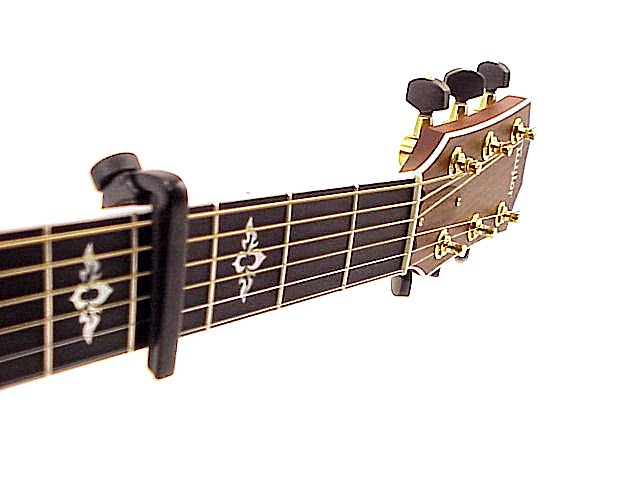USING A CAPO

In order to make playing in difficult keys easier, guitarists use a device known as a "capo". This may look like a medieval instrument of torture but, as a guitarist, it's one of your best friends! It acts as a first finger substitute holding a barre, or can be alternatively thought of as a movable nut. If a key would normally mean lots of barre chords (and an aching hand) the capo will allow you to turn most of the barre chords into open string shapes.
Here's an example: you need to play a song that was recorded in Ab major and uses Bbm, Cm, Db, E, and Fm - all barre chords. If you put the capo at the first fret each chord can be played with the shape of the chord a semitone below it.
Actual pitch: Ab Bbm Cm Db Eb Fm
Capo 1 shapes: G Am Bm C D Em
Much easier, and it sounds better too! And that's not the only way we could do it...
Actual pitch: Ab Bbm Cm Db Eb Fm
Capo 4 shapes: E F#m G#m A B C#m
Or, for an extreme contrast...
Actual pitch: Ab Bbm Cm Db Eb Fm
Capo 8 shapes: C Dm Em F G Am
You will notice that as the capo goes up the neck the timbre of the guitar will change. This is something that songwriters use deliberately. They also use a capo to shift a chord sequence up or down a key to better suit their voice, which saves learning a new set of chords. Lastly, if you play guitar with a friend, using a capo high on one of the guitars can create a resonant sound with the two guitars playing the same chords high and low:
Actual pitch: G Am Bm C D Em F
Guitar 1
Open chords: G Am Bm C D Em F
Guitar 2
Capo 7 shapes: C Dm Em F G Am Bb
Materials are from the book Guitar.

No comments:
Post a Comment